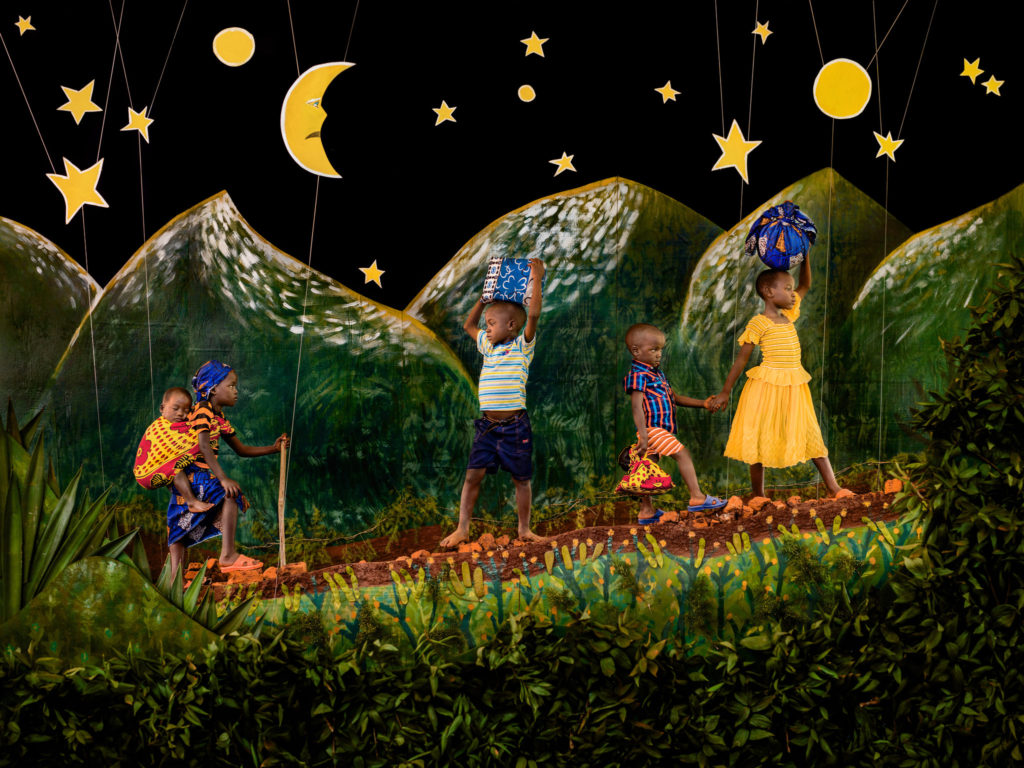Photojournalism is in a constant struggle to remain relevant and financially viable, with shrinking budgets and new storytelling practices driving leading institutions to undertake major changes.
World Press Photo, the industry standard-bearer, said last week that it would initiate a new “creative documentary photography” contest. The news has sparked heated online debate among photojournalists over the future of the profession and the ethics of blurring truth with fiction. “Purists” argue that photojournalism must not be tainted by staged or contrived photography. “Creatives” argue in favor of more conceptual ways of telling stories.
LagosPhoto, an annual monthlong festival currently hosting its seventh edition in Nigeria’s largest city, has long championed the kind of creative approach now being embraced by World Press Photo.
“I think we are far ahead of the curve in that sense,” said Azu Nwagbogu who founded LagosPhoto in 2010 and has promoted conceptual photography over documentary work as a way to explore the subjective notion of truth. “It’s not that we aren’t interested in photojournalism, but Africa has become a playground for photographers coming to tell the ‘truth’ about the continent and they get stuck on the ‘hopeless’ narrative. We can sculpt so much more than this.”

The theme for this year’s festival, which opened last week and runs through Nov. 21, is “Rituals and Performance: Inherent Risk.” Featured work includes Fati Abubakar’s “The Face Series,” a collection of portraits focusing on the resilience of her fellow Nigerians living in rural and rundown locations, and Kiluanji Kia Henda’s “Self-Portraits as a White Man,” in which the Angolan artist aims to elicit a reflection on art as a historical document. Jenevieve Aken’s “Great Expectations” is inspired by the Dickens novel, which prompted the Nigerian artist to explore how African culture values marriage over a woman’s freedom, happiness and independent accomplishments. Patrick Willocq’s “The Art of Survival” is a project commissioned by the international charity Save the Children and produced in collaboration with displaced communities.
The range of work offers insight into the kind of photography that could fit into the new World Press Photo creative documentary framework. Mr. Willocq, who is French, is building on his previous projects with the Democratic Republic of Congo’s pygmy communitiesby engaging with refugees to creatively address some of the world’s most pressing social and political issues. While the global migration crisis has been extensively documented, Mr. Willocq hopes that by interviewing refugee children and camp workers and collaborating with them to build fantastical dioramas, he can offer a fresh and optimistic perspective that adds nuance and hope to the all-too-familiar scenes of catastrophe and suffering.
Ms. Abubakar’s “The Face Series” expands on the photographer’s continuing “Bits of Borno” project and provides a rare insider’s glimpse of daily life under the shadow of Nigeria’s Boko Haram Islamic militants in the northeastern corner of Africa’s most populous country. In seeking out images in her hometown, Maiduguri, Ms. Abubakar has become a local celebrity of sorts, prompting residents to engage with her and pose for photographs.
“The very essence of creative expression on the continent lies in rituals and how, when these rituals encounter an audience, it becomes a performance,” Mr. Nwagbogu said. “Even a ritual for one’s self becomes participatory. Abubakar’s practice of returning to the same places to photograph the same people over and over again has become a ritual of its own.”

In its seven years, LagosPhoto has played an outsize role in increasing photographic literacy in Africa by bringing together some of the best visual artists working on the continent and by hosting weeks of exhibitions, panel discussions and workshops aimed at filling an institutional education gap.
“What is needed now is access to markets overseas, real mentoring and a long commitment to improving the education infrastructure,” said Gary Knight, a former chairman of the World Press Photo contest and an ambassador for Canon, which runs Project Miraisha, an initiative that over the past two years has worked with 2,000 aspiring African photographers. Mr. Knight ran a workshop this year at LagosPhoto.
“Trying to do that at a national level is very difficult to imagine,” he said. “Doing it through a festival like the LagosPhoto is — I think — the best way to make that happen.”
For Jacques Nkinzingabo, a 22-year-old Rwandan photographer who attended the festival for the first time this year, the experience provided a welcome boost.

“It’s helped me improve my skills, and you really learn the value of your work and how to tell our own stories,” Mr. Nkinzingabo said. “One of my dreams now is to go back to Lagos and have my own exhibition there.”
The heavy focus on conceptual photography at LagosPhoto has provided creative inspiration for a new generation of African photographers just as the broader photojournalism industry grapples with how to accommodate new narrative forms.
The LagosPhoto Festival is terrific, Mr. Knight said, because it exposes African photographers “to intelligent and critical thinking, which they don’t get at institutions of higher education that teach photography.”
“I wish it had room for more work in documentary and journalism genre,” he said, “and I hope they will make a little space for that simply because civil society needs it, if for no other reason.”
Finbarr O’Reilly is a co-author of the forthcoming book “Shooting Ghosts,” about the psychological costs of war, to be published next summer by Viking. He won the 2005 World Press Photo of the Year award, and was based in Africa as a photographer and journalist from 2001 through 2014. He is currently a writer in residence at the Carey Institute for Global Good and a 2016 MacDowell Colony fellow. Follow him on Instagram and Twitter.

